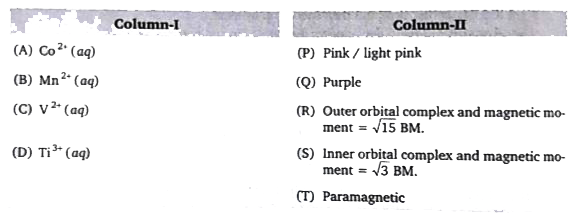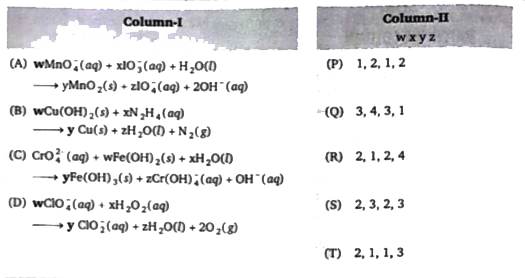Match the entries of column I with appropriate entries of coloumn II. Each entry in column I may have one or more than one correct option from column II. If the correct matches are A-p, s , B-r, C-p, q , D-s, then the correctly bubbled 4 4 matrix should be as follows :
The correct Answer is:A-p, s ; B-q, s ; C-r, t ; D-q, t
To solve the matching problem between Column I (Reactions) and Column II (Products), we need to analyze the reactions of copper and zinc with dilute and concentrated nitric acid (HNO3) and identify the products formed.
1. Identify the Reaction for A: Cu + Dil. HNO3
- When copper reacts with dilute nitric acid, the primary products are copper(II) nitrate (Cu(NO3)2) and nitrogen monoxide (NO).
- Balanced Reaction:
3Cu+8HNO3→3Cu(NO3)2+2NO+4H2O
- Match: A matches with (p) NO and (s) Cu(NO3)2.
2. Identify the Reaction for B: Cu + Conc. HNO3
- When copper reacts with concentrated nitric acid, the products are copper(II) nitrate (Cu(NO3)2) and nitrogen dioxide (NO2).
- Balanced Reaction:
Cu+4HNO3→Cu(NO3)2+2NO2+2H2O
- Match: B matches with (q) NO2 and (s) Cu(NO3)2.
3. Identify the Reaction for C: Zn + Dil. HNO3
- When zinc reacts with dilute nitric acid, the products are zinc nitrate (Zn(NO3)2) and nitrous oxide (N2O).
- Balanced Reaction:
Zn+4HNO3→Zn(NO3)2+2N2O+2H2O
- Match: C matches with (q) N2O and (t) Zn(NO3)2.
4. Identify the Reaction for D: Zn + Conc. HNO3
- When zinc reacts with concentrated nitric acid, the products are zinc nitrate (Zn(NO3)2) and nitrogen dioxide (NO2).
- Balanced Reaction:
Zn+4HNO3→Zn(NO3)2+2NO2+2H2O
- Match: D matches with (q) NO2 and (s) Zn(NO3)2.
Final Matches:
- A: (p) NO, (s) Cu(NO3)2
- B: (q) NO2, (s) Cu(NO3)2
- C: (r) N2O, (t) Zn(NO3)2
- D: (q) NO2, (s) Zn(NO3)2
Summary of Matches:
- A - p, s
- B - q, s
- C - r, t
- D - q, s
- When copper reacts with dilute nitric acid, the primary products are copper(II) nitrate (Cu(NO3)2) and nitrogen monoxide (NO).
- Balanced Reaction:
3Cu+8HNO3→3Cu(NO3)2+2NO+4H2O
- Match: A matches with (p) NO and (s) Cu(NO3)2.
- When copper reacts with concentrated nitric acid, the products are copper(II) nitrate (Cu(NO3)2) and nitrogen dioxide (NO2).
- Balanced Reaction:
Cu+4HNO3→Cu(NO3)2+2NO2+2H2O
- Match: B matches with (q) NO2 and (s) Cu(NO3)2.
- When zinc reacts with dilute nitric acid, the products are zinc nitrate (Zn(NO3)2) and nitrous oxide (N2O).
- Balanced Reaction:
Zn+4HNO3→Zn(NO3)2+2N2O+2H2O
- Match: C matches with (q) N2O and (t) Zn(NO3)2.
- When zinc reacts with concentrated nitric acid, the products are zinc nitrate (Zn(NO3)2) and nitrogen dioxide (NO2).
- Balanced Reaction:
Zn+4HNO3→Zn(NO3)2+2NO2+2H2O
- Match: D matches with (q) NO2 and (s) Zn(NO3)2.
- A: (p) NO, (s) Cu(NO3)2
- B: (q) NO2, (s) Cu(NO3)2
- C: (r) N2O, (t) Zn(NO3)2
- D: (q) NO2, (s) Zn(NO3)2
- A - p, s
- B - q, s
- C - r, t
- D - q, s
Topper's Solved these Questions
- P-BLOCK ELEMENTS Book:PRADEEPChapter:P-BLOCK ELEMENTS Exercise:INTEGER TYPE QUESTIONS
Explore 15 Videos
- P-BLOCK ELEMENTS Book:PRADEEPChapter:P-BLOCK ELEMENTS Exercise:ASSERTION-REASON TYPE QUESTIONS
Explore 30 Videos
- P-BLOCK ELEMENTS Book:PRADEEPChapter:P-BLOCK ELEMENTS Exercise:MCQ
Explore 164 Videos
- ORGANIC COMPOUNDS CONTAINING NITROGENBook:PRADEEPChapter:ORGANIC COMPOUNDS CONTAINING NITROGENExercise:IMPORTANT QUESTIONS FOR BOARD EXAMINATION
Explore 27 Videos
- POLYMERSBook:PRADEEPChapter:POLYMERSExercise:IMPORTANT Questions (For Board Examination)
Explore 27 Videos
Similar Questions
Match the entries of column I with appropriate entries of coloumn II. Each entry in column I may have one or more than one correct option from column II. If the correct matches are A-p, s , B-r, C-p, q , D-s, then the correctly bubbled 4 × 4 matrix should be as follows :
Column IColumn II(A)SO2(p)Basic(B)H2SO4(q)Acidic(C)HNO3(r)Reducing(D)NH3(s)Oxidising
View SolutionMatch the enteries of column I with appropriate entries of column II Each entry in column I may have one or more than one correct option from column II .
Column I Column II (A)Magnesium (p)p−Block (B)Aluminium (q) Metal (c)Arsenic (r) s- Block (D)Iodine (s) Metalloid
View SolutionMatch the entries of column I with appropriate entries of coloumn II. Each entry in column I may have one or more than one correct option from column II. If the correct matches are A-p, s , B-r, C-p, q , D-s, then the correctly bubbled 4 × 4 matrix should be as follows :
Column IColumn II(A)H3PO3Δ−−→(p)One of the products acts as a reducing agent.(B)PCl3+H2OΔ−−→(q)One of the products is a tribasic non-reducing acid.(C)NO2+H2O→(r)Dehydration(D)HNO3+P4O10Δ−−→(s)In one of the products, central atom has +5 oxidation state.
View SolutionMatch the enteries of column I with appropriate entries of column II Each entry in column I may have one or more than one correct option from column II .
Column I Column II (A)C1 ,Br, I(p)Ionization enthalpy increases (B)B,C,O (q)Negative elecron gain enthalpy decreases (C)O2−,O−,O−, O(r) Atomic size decreases (D)C1 ,F ,P(s)Belong to the same group
View SolutionMatch the entries of column I with appropriate entries of column II. Each entry in column I may have one or more than one correct option from column II. If the correct matches are A-p, s , B-r , C-p, q , D-s, then the correctly bubbled 4×4 matrix should be as follows :
Column IColumn II(A)Rate constant of an exothermic reaction(p)increases with increase of themperature.(B)Rate constant of an endothermic reaction(q)decreases with increase of temperature.(C)Equilibrium constant of an exothermic reaction(r)not affected by adding catalyst.(D)Equilibrium constant of an endothermic reaction(s)not affected by change of initial concentration.
View SolutionMatch the entries of column I with appropriate entires of column II Each entry in column I may have one or more than one corret option from column II if the correct matches are A-p,s, B-r,C-p,q,D-s then the correctly bubbled 4×4 matrix should be as follows:
column Icolumn II (A)Electrode on which reduction occurs (p)Anode(B)Electrode on which oxidation occurs(q)Cathode(C)Electrode connected to positive pole of the battery(r)Negative pole(D)Electrode connected to negative pole of the battery(s)positive pole
View SolutionMatch the entries of column I with appropriate entires of column II Each entry in column I may have one or more than one corret option from column II if the correct matches are A-p,s, B-r,C-p,q,D-s then the correctly bubbled 4×4 matrix should be as follows:
column Icolumn II (A)Electrode on which reduction occurs (p)Anode(B)Electrode on which oxidation occurs(q)Cathode(C)Electrode connected to positive pole of the battery(r)Negative pole(D)Electrode connected to negative pole of the battery(s)positive pole
View SolutionEntries of Column-I are to be matched with entries of Coloumn-II. Each entry of Column-I may have the matching with one or more than one entries of Column-II.

View SolutionEntries of Column-I are to be matched with entries of Coloumn-II. Each entry of Column-I may have the matching with one or more than one entries of Column-II.

View SolutionEntries of Column-I are to be matched with entries of Coloumn-II. Each entry of Column-I may have the matching with one or more than one entries of Column-II.

View Solution